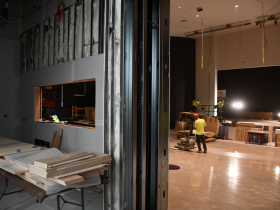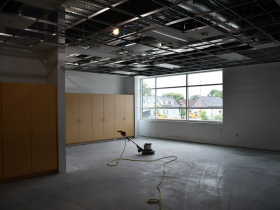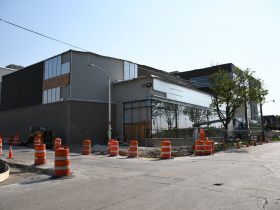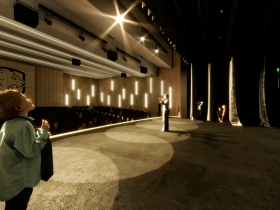Inside St. Augustine’s Huge Expansion
K4-12 private choice school adding new $49 million school building.
One of Milwaukee’s biggest and highest-performing schools is about to become substantially larger.
St. Augustine Preparatory Academy will open its new, $49 million elementary school building this fall, making the relatively new K4-12 school the largest single-campus school in the city.
The private choice school, located at the intersection of S. 6th Street and W. Harrison Avenue in the Lincoln Village neighborhood, will be capable of housing 2,400 students across its elementary and high school buildings. A four-year growth plan aims to fill the campus.
“This next year, we are adding one class per grade level, with the exception of fifth grade, where we already had so many students on the wait list we actually have two,” said CEO Abby Andrietsch on a tour of the construction site. An additional round of classes will be added in the 2025-26 school year, with a plan of five classes per grade level and an elementary student body of 825 to 850.
The school opened in 2017 as a high school and for the last three years St. Augustine has operated with K4-12 students all in one building. The new building will result in space for each grade level to grow, in part by freeing up space in the existing 225,000-square-foot building. It will also allow Augustine Prep to augment the numerous athletic facilities in the high school with a number of art facilities in the new building.
A 606-seat theater with orchestra pit, theater management training facilities and auxiliary shop spaces will allow the school to establish a robust theater program. “It’s a space we want to share with the community,” said Andrietsch about the plan to allow outside groups to host events. The theater and purpose-built music rooms on the top floor of the three-story building will be shared across the entire student body. Middle school and high school students will cross the street to use the new facilities.
A new library will allow a smaller one in the high school to be converted to a family center. A full-size gymnasium is included in the middle of the new school. Atop the gym, an open-air deck and garden is being constructed in the middle of the third floor that will bring more natural light in and allow potential programming. “One of things we have learned in the first six years is people really value sunlight,” said Andrietsch. That’s visible in the classrooms, which mix sizable windows with wall space for displays. A suite of staff offices and parent meeting rooms can also be found in the new building.
The school’s religious focus is evident in a special room for its “Godly Play” curriculum. The school operates on a four-pillar model that includes faith, family, academics and athletics and arts.
High school students must pick one “major” in both the arts and in STEM (science, technology, engineering and mathematics), which leads to several outside engagement opportunities with partner organizations. “We figured out we don’t have to do it all. A lot of what we do is figure out how we can build partnerships to help our kids,” said Andrietsch.
The school was created by Gus Ramirez, Andrietsch’s father. The Ramirez family, which acquired and substantially grew Husco International, donates millions to the school annually, supplementing the Milwaukee Parental Choice Program’s $8,500 per student voucher. It will cover an estimated 80% of the cost of the new building, with the remainder coming from New Market Tax Credits and private fundraising.
But Andrietsch, who gave the tour in early June shortly after the school hosted a fundraising gala that raised $2.1 million, noted that the support now goes far beyond her extended family. For instance, the Milwaukee Bucks and Pat Connaughton are supporters of the new gym.
After the expansion opens, the middle school and high school grade levels will remain larger than elementary school grades.
“Sixth grade and ninth grade are two really strong transition points for students in Milwaukee,” she said, explaining how students can enter the St. Augustine system at multiple age levels. “High school grows the most because that’s where we see the most need.”
Within two miles of the campus, St. Augustine estimates there are 26,000 students in 12 schools. “About 17,000 of which are in mediocre or failing schools,” said the school CEO of the Wisconsin Department of Public Instruction‘s (DPI) school report cards.
Augustine Prep is a leader, with a 95% retention rate and a five-star rating from DPI, the highest level awarded.
But there isn’t a plan to try to build even more buildings.
“I want us to document the model in a way that’s easy to share with other schools,” said Andrietsch, who previously served as the executive director of Schools That Can Milwaukee, of what’s next. She said she’s also working to build out an endowment for the school, which would defray the cost of tuition for non-voucher students. The school spends about $12,000 per year per student, exceeding the public voucher by a couple thousand dollars.
At a June 2022 groundbreaking, Andrietsch said 91% of the students are of Hispanic descent, but a family-tree research project revealed those students can trace their family’s origin back to more than 40 different countries. More than 80% of the students come from four neighboring ZIP codes. Eighty-seven percent come from low-income households that qualify for free or reduced lunch. Approximately 8% participate in the school’s special education program.
Andrietsch said Augustine Prep works with student families to attempt to provide support. That includes supporting Acts Housing‘s homebuying counseling programs. “I am a deep believer in the stability of homeownership having a big impact on a community and a child’s life,” she said. The school does not provide busing, part of a strategy to increase parent engagement.
The Final Piece of the Block
The elementary school sits on a full-block site that wasn’t vacant when the project started.
To create the site for the elementary school, an entire block of approximately 30 homes was purchased and demolished for a total of approximately $2 million. As part of a smaller 2019 vision, the school acquired three of those properties from the city for $500 each and will make a $20,000 annual payment-in-lieu-of-taxes (PILOT) payment.
But after acquiring even more private parcels, Augustine Prep expanded the project to add more parking and the theater. But it couldn’t get the one remaining city-owned lot at the northwest corner of the block bounded by W. Arthur Ave., W. Harrison Ave., S. 5th St. and S. 5th Pl.
Ramirez, at the 2022 groundbreaking, pledged to continue to lobby Mayor Cavalier Johnson to acquire the property, once used as a community garden.
“That lot has not been maintained at all for at least the last year,” said Andrietsch during the June tour.
On Tuesday, the school got its wish. The Zoning, Neighborhoods & Development Committee unanimously endorsed selling the lot for $500.
Parking will be built on the property, with outdoor play areas for students located between the parking lot and school. Owing to the slope of the site, the age-separated playgrounds are partially below grade, with concrete barriers that will eventually be covered by murals.
For more on the complicated policy question of how to support large new buildings on the densely populated South Side, see our January and 2021 coverage.
VJS Construction Services is constructing the new building. Korb + Associates Architects is designing the school.
Interior Photos
Exterior Photos
2022 Renderings
If you think stories like this are important, become a member of Urban Milwaukee and help support real, independent journalism. Plus you get some cool added benefits.
Eyes on Milwaukee
-
Church, Cupid Partner On Affordable Housing
 Dec 4th, 2023 by Jeramey Jannene
Dec 4th, 2023 by Jeramey Jannene
-
Downtown Building Sells For Nearly Twice Its Assessed Value
 Nov 12th, 2023 by Jeramey Jannene
Nov 12th, 2023 by Jeramey Jannene
-
Immigration Office Moving To 310W Building
 Oct 25th, 2023 by Jeramey Jannene
Oct 25th, 2023 by Jeramey Jannene









































Here is a school that will be getting tens of millions taxpayer dollars with no real accountability or transparency in how this money is spent while the school retains the ability to cull the student body of any student that might be challenging to educatedand refusing admission to most special education students.
When voucher schools like this accept all students regardless of their needs – then we can talk about performance. Do they accept children in these categories? With Jeramy’s glowing praise of this school he needs to clarify what students they don’t accept and the reason why and how that impacts overall performance of the school.
Autism
Blind and Visually Impaired
Deaf and Hard of Hearing
Emotional Behavioral Disablitity
Intellectual Disability
Orthopedic Impairment
Other Health Impairment
Significant Developmental Delay
Specifica Learning Disability
Speech and Language
Traumatic Brain Injury
I’m unclear on the statement above regarding accountability. The article indicates that the WI Department of Public Instruction monitors/evaluates the school. Is there some other WI State department this school is required to report to?
Regarding the statement on transparency, I’m curious on what ( besides operating the school ) they would spend the $8500 on?
Last question is: is $8500 the actual amount spent per student in that area’s public school or is $8500 the the actual cost per student in that area’s public school, or is $8500 the result of some mystical formula?
Appreciate your insight, thank you.
… and question for the 2nd comment: your detailed list steers me to believe you’re more knowledgeable than UM about the topic.
Make life simple for readers… can you clarify what students this school doesn’t accept and the reason why and how that impacts overall performance? And if you could provide a link to the specific data source is much appreciated. I’m curious to learn more about how my tax $ is being spent & appreciate your insight, thank you
Imagine if public schools got even a fraction of the money that’s getting stolen to fund these private schools.
Simply disgusting what’s going on.
So it is correct to say that every school that is not considered a ‘public school is considered a voucher school regardless of whether there is a religious affiliation or not? Is the voucher dependent upon the parent requesting it or is the money automatic?
Can anyone supply the per student dollars the public schools get?
Kaygeert – Voucher schools are private schools that use taxpayer dollars to subsidize the cost of private education for K4-12 students from lower-income families in the form of a voucher. The payments go directly from the state to the school based on the number of voucher students enrolled at the school at the beginning of each semester.
Parents who qualify may choose to send their children to private voucher schools instead of their local public school.
In Wisconsin, voucher schools are those currently participating in at least one of four state-run, state-funded programs: the Milwaukee Parental Choice Program, the Racine Parental Choice Program, the Wisconsin Parental Choice Program and the Special Needs Scholarship (SNSP) Program.
For 2023-24, the annual voucher payment is $8,399 for K-8 students, and the schools cannot charge additional tuition from these families. For grade 9-12 students, the annual payment is $9,045, and schools may charge additional tuition if the family’s income exceeds 220% of the federal poverty level, which is $61,050 for a family of four.
https://wisconsinwatch.org/2023/05/considering-a-wisconsin-voucher-school-heres-what-parents-should-know/
@keygeeret – Private schools opt into the Milwaukee Parental Choice Program (or other programs across the state). A number of them are not religious. The money is automatic, if the student is qualifies (income restrictions) and enrolls in the program.
The amount spent and received (from the state) for public schools varies by district.
@wardt01 – The voucher amount (which will rise as part of the Act 12 bargaining) is set by a formula and doled out by the state on “third Friday” count days across the year.
@Paul Trotter – Unlike many voucher schools, St. Augustine does have a sizable special education population. It’s something I explicitly asked about, but with a focus on speech services given that my wife is a speech therapist at MPS. As you might be hinting at, voucher and charter schools can not explicitly refuse a student because of their special needs, but they may not provide the services the student needs (creating a de facto refusal) or they may not provide the quality of the service the student needs (resulting in the student slowly transitioning back to MPS). The way it works from a policy perspective is, simply put, a complete mess.